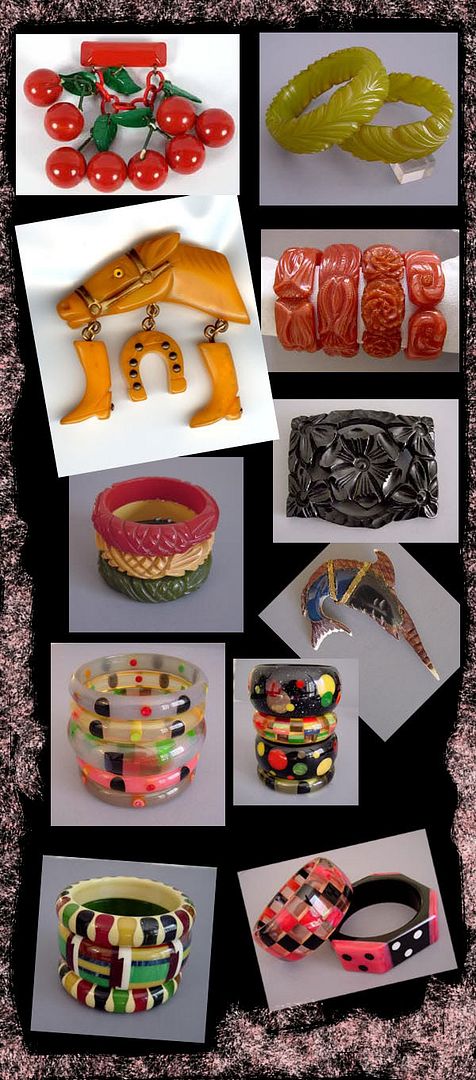I thought I would share a little bit of its history with you all, and give a few pointers on how to identify real Bakelite in a sea of good fakes. The stuff can be tricky because it comes in so many different colors and forms, but there are a couple no fail ways to make sure it's real.
Bakelite was the first plastic manufactured from synthetic materials and was developed between 1907-1909 by Belgian Dr. Leo Baekeland. It is a combination of phenol, formaldehyde and generally wood flour filler. Manufacturing was a vary labor intensive process! Although it was used early on in products such as phones, radios, furniture, billiard balls, and telephones it did not become wildly popular until 1927 when its original patent expired and many different companies began to manufacture it. Bakelite soon became one of the most popular substitutes for traditional materials because it was cheap to manufacture and could easily take many forms and colors.
Initially, there was a backlash against Bakelite because the upper class saw it as a cheap, crass material. However, the streamlined, sculptural design tendencies of the late 30's and 40's were complementary to the simplicity of Bakelite. Also, the Great Depression forced people to become more resourceful and Bakelite was an inexpensive, fun substitution for other materials. It was easy to carve and was conducive to the streamlined, minimalist designs that came to full fruition post WWII and into the 50's as well as the whimsical and escapist jewelry designs that were so popular in these eras as well.
Bakelite can sometimes be tricky to identify simply because it came in so many forms and colors. The images below exhibit the diverse spectrum of Bakelite in jewelry. Some of the more common colors were butterscotch, as seen in the horse pin, green, and red. Less common were patterned and "apple juice" (translucent) Bakelite, seen in the highly collectible bangles below. Generally the rule is the more ornate the carving or interesting the design, the more valuable the piece.

All these lovely images were found here.
So with all the variety out there, how can you tell it's real? There are several ways, some more fancy than others:
The Simichrome test: Simichrome is a material used to clean metals. Put a bit on a clean, light colored soft cloth and gently rub the piece in question. If it's Bakelite, a little bit of yellow residue will show up on your cloth.
409 Test: Put a bit of 409 on a Q-tip and rub. If it turns yellow, it's Bakelite. Black and laquered often fail this test though.
Smell: Bakelite has a distinct smell, kind of like petroleum jelly. Vigorously rub one area of the piece and smell it. If it kinda smells like formaldehyde, bingo! This test may not work on older pieces all the time though.
Sound/ Touch/ Site: Bakelite is heavier than most modern plastics and will make a distinctive clunking sound when hit against another piece. You should also check for scuff marks and chipping in carved pieces, a tell-tale sign of age.
I hope this has been helpful, and happy treasure hunting. You never know where a nice piece of this stuff might surface, so it's always good to be prepared!
409 Test: Put a bit of 409 on a Q-tip and rub. If it turns yellow, it's Bakelite. Black and laquered often fail this test though.
Smell: Bakelite has a distinct smell, kind of like petroleum jelly. Vigorously rub one area of the piece and smell it. If it kinda smells like formaldehyde, bingo! This test may not work on older pieces all the time though.
Sound/ Touch/ Site: Bakelite is heavier than most modern plastics and will make a distinctive clunking sound when hit against another piece. You should also check for scuff marks and chipping in carved pieces, a tell-tale sign of age.
I hope this has been helpful, and happy treasure hunting. You never know where a nice piece of this stuff might surface, so it's always good to be prepared!



No comments:
Post a Comment